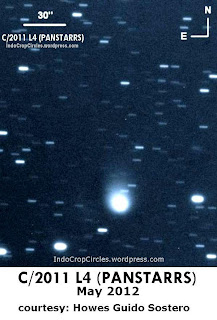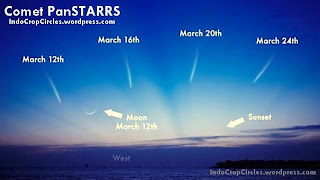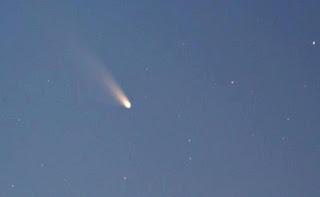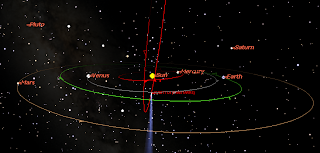 |
| Discovery of comet C/2011 L4 image (PANSTARRS). Comets are marked with arrows. Photo Credit: Space.com, 2011 |
 |
The next series of observations made by various observatories concluded that the comet C/2011 L4 (PANSTARRS) is a hyperbolic comet (eccentricity> 1) orbit with an inclination of 85o and perihelion 0.3 AU (45 million km) to be achieved at 11 + March 8, 2013 future. Perihelion is so short that will enter the field of view of solar observation satellite.
"As for how the comet would react to the sun is hard to predict. Since this is your first visit Comet Pan-STARRS, has never been tested by the gravitational pull of the sun and the heat, almost anything can happen. The comet is still new, so there might be other properties that we do not know, "said Karl Battams of the Naval Research Laboratory.
However, it may still be difficult to see from the point of view on Earth, because the comet will be very close to the sun. This means that the comet can only be observed in the evening when the sky is not completely dark.
Most Brightest
What is interesting from the comet C/2011 L4 (PANSTARRS) are his chances of being luminous comet. There are two factors that support it.First, the comet C/2011 L4 (PANSTARRS) found when they wander along its orbit between the orbits of Jupiter and Saturn. Against the Sun, the comet is still within 7.9 AU when found. While on Earth, the comet is still within 6.9 AU. This indicates that the core of comet C/2011 L4 (PANSTARRS) large enough that can be detected, though still quite far away. Data from 41 observations showed the comet nucleus C/2011 L4 (PANSTARRS) has an absolute magnitude 10.5 that predicted a 30 km diameter core. This situation is reminiscent of the discovery of comet Hale-Bopp in 1995, which at that time still further than Jupiter. Two years later the comet Hale-Bopp comet to be one brightest when approaching it perihelion and known to have a core diameter of 40 km, the largest among the other comets that have been known except comet 95 / P Chiron.
Secondly, this comet perihelion short enough so that it receives the solar wind pressure is stronger when in perihelion. With the absolute magnitude of the comet +6 while in perihelionnya comet C/2011 L4 (PANSTARRS) estimated to have a visual magnitude +2. However, due to an increase in the comet brightness is controlled by the pressure of the solar wind, the comet C/2011 L4 (PANSTARRS) potentially more luminous than the estimate due to increased activity of the gas and dust emission in the crust core. Moreover, this comet is a comet that had just crossed into the inner solar system after initially snapped out of their nest in the Oort cloud comets. As a new comet, comet C/2011 L4 (PANSTARRS) still contains many volatile compounds in the crust. The two factors that make the comet C/2011 L4 (PANSTARRS) likely to be a comet tercerlang in the last decade especially after the appearance of the comet McNaught in 2007.
When and Where
For Indonesia, my beloved region, the DOI will be at its peak on 10-11 March 2013. With a position 10 degrees to the west. |
| Simulation on Stellarium |
 | |
| The position and time of the comet appears Panstarrs |
 |
| Panstarrs sightings in New Zealand February 27, 2013 |
Stellarium
If you already have Stellarium, please open the file ssystems.ini in Stellarium with notepad and add the following data (copy and paste) on ssystems.ini, then save it:[PANSTARRS]
name = PANSTARRS
parent = Sun
radius = 10
oblateness = 0.0
halo = true
color = 1.0,1.0,1.0
tex_halo = star16x16.png
tex_map = nomap.png
coord_func = comet_orbit
orbit_TimeAtPericenter = 2456329.3937
orbit_PericenterDistance = 0.337628
orbit_Eccentricity = 1.0
orbit_ArgOfPericenter = 331.2931
orbit_AscendingNode = 67.5247
orbit_Inclination = 59.95487
lighting = false
albedo = 1
orbit_visualization_period = 365.25
Turn on your Stellarium and position of the comet will be visible on the display of Stellarium.











0 comments:
Post a Comment